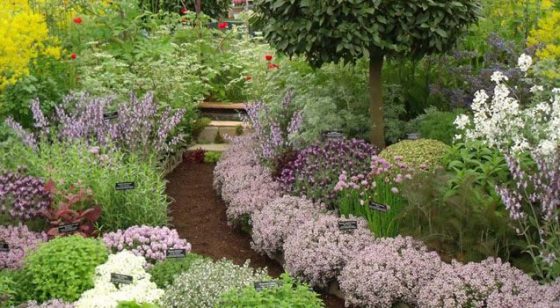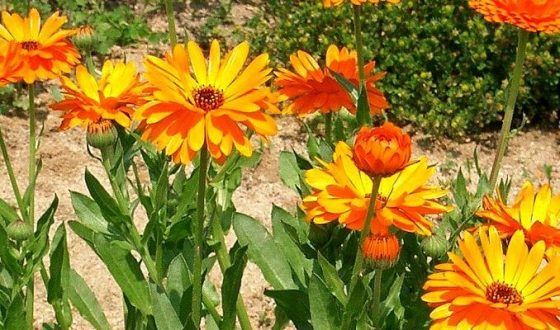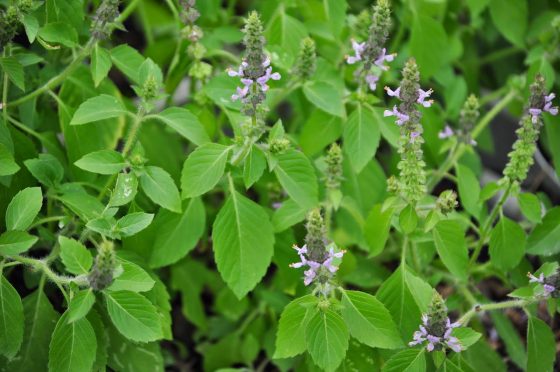
TRUMP SAYS: HUNTER MAKES FORTUNE FROM SHADY DEALS!
BIDEN FAMILY STINKS TO HIGH HEAVENS OF CORRUPTION!
DON'T GET LEFT OUT: HUNTER MUST BE STOPPED!

This article was originally published by Sara Tipton at Tess Pennington’s ReadyNutrition.com
Tess is the author of The Prepper’s Blueprint: How To Survive ANY Disaster

Having medicinal plants growing on your property may not seem like all that big of a deal to some. But if you enjoy the scent and making your own fresh teas, some of these plants may be just right for you! Plus, there’s the added bonus of having these medicinal herbs around and readily available for use when you need it the most.
In a perfect world, we would each have all of our favorite garden herbs, tailored to our particular climate and health concerns, growing abundantly and readily available. Often life gets in the way and with so many plants having so many wonderful benefits, it is hard to know where to start. So we’ve put together this helpful list of three more medicinal herbal plants that are both easy to grow and offer a well-rounded approach to herbal health. They all have the added bonus of being beautiful additions to any home or garden too!
CALENDULA (POT MARIGOLD)

The calendula flower is edible! They can be made into teas or the flowers can be tossed into a salad to offer a quick and easy flavor boost. The whole flower can be used as a medicinal herb in treating skin conditions, which is why calendula is often found in topical ointments, salves, and creams. These ointments have also proven to have the added bonus of repelling annoying and bite-happy mosquitoes. The plus side of using calendula to chase away mosquitoes is that it is child safe and non-toxic, unlike most bug sprays on the market today. The effects are short-lived, lasting only about two hours, but its fairly easy to just reapply. Additionally, the plant itself is known for its treatment of diaper rash and is the herb most likely to be found in “baby butt” creams. It can be used for a wide variety of skin ailments. Calendula flowers are often used internally in tinctures and broths as an anti-fungal, anti-bacterial, lymphagogue (stimulates the lymphatic system), emmenagogue (stimulates the menses), and digestive system anti-inflammatory. The flowers are commonly used to lift spirits and support the immune system. The whole flowers can also be dried and added to soups and stews in the winter as an immune tonic.
Calendula is fairly easy to grow too. The plant prefers full sun and average garden soil. Calendula does well as a container plant, hence the common name “pot marigold” and would look lovely sitting in a large pot in front of a house. It can be easily grown from seed and will tolerate either direct sow or an early start in pots. The seedlings, luckily, are somewhat cold tolerant too, so don’t worry if you live in a cooler climate. Plant each seed 10-14’ inches apart. The plant grows to about 18 inches tall. Calendula’s sticky flowers must be picked every two to three days to ensure a longer flowering season. The plant will usually self-sow unless you mulch heavily. It is typically grown as an annual but can be cultivated as a short-lived perennial in warmer climes (Zone 8-10).
ECHINACEA (PURPLE CONEFLOWER)

Echinacea is one of the most popular garden ornamentals with its showy purple flowers that attract all manner of butterflies and bees. But it is also a common addition to teas that assist with the recovery of a cold or the flu as a powerful immune system booster. In fact, the entire plant from the roots, seeds, and fresh flowers are all medicinal and can be made into a flavorful immune-stimulating tea or tincture.
Echinacea is not only really easy to grow, but it is also a decidedly unfussy plant, withstanding drought, disease, and insect infestations. Echinacea is an herbaceous perennial that you will want to plant in full sun for the best flower production. Plant seeds 1-2 feet apart because the plant grows to 3-4 feet tall. You can sow echinacea in greenhouse trays or directly in the ground in early spring. Germination will occur in 2-3 weeks. To improve the germination rate you may cold condition (stratify) the seeds for two weeks prior to planting. It will begin flowering the second year and will be two or three years old before the roots are ready to harvest. Echinacea seeds will self-sow if left on the plant over winter.
BASIL (TULSI)

Many people use basil in an Italian seasoning for pizzas or pasta toppings because it’s excellent in sauces! But it also has a wonderful medical benefit of being antimicrobial and its scent has been shown to boost and enhance a person’s mood. The leaves and flowers are used as a medicinal tea for colds, coughs, asthma, bronchitis, sinusitis, headaches, arthritis, diabetes, stress, and anxiety. Fresh leaves can be added to salads for a flavor boost as well. Try putting some in a basil pesto! Your taste buds will thank you!
Much like the echinacea plant, basil is also easy to grow. It is easy to grow from seed, but take care not to plant the seed too deep because it’s so small. It will germinate better with bottom heat. Basil is a perennial in Zone 10 and warmer, however, it is grown elsewhere as an annual. It will get 1-2 feet tall and 6 inches to 1 foot wide. Plant basil in full sun in average to moist garden soils. If your greenhouse gets too cold at night, basil will be slow to sprout and slow to grow, so you’ll need patience. You can also plant it outside after the danger of frost has passed. The basil plant may appear small when you first plant it, but when the days grow longer and the nighttime temperatures warm, it will take off!
**This article is was written for information purposes only. It is not meant to treat or diagnose any problem, disease, or health issue. Please contact your doctor if you have any concerns about your health.
Tess Pennington is the author of The Prepper’s Blueprint, a comprehensive guide that uses real-life scenarios to help you prepare for any disaster. Because a crisis rarely stops with a triggering event the aftermath can spiral, having the capacity to cripple our normal ways of life. The well-rounded, multi-layered approach outlined in the Blueprint helps you make sense of a wide array of preparedness concepts through easily digestible action items and supply lists.
Tess is also the author of the highly rated Prepper’s Cookbook, which helps you to create a plan for stocking, organizing and maintaining a proper emergency food supply and includes over 300 recipes for nutritious, delicious, life-saving meals.
Visit her website at ReadyNutrition.com for an extensive compilation of free information on preparedness, homesteading, and healthy living.

It Took 22 Years to Get to This Point
This article was originally published by Michael Snyder at The Economic Collapse Blog. When one...
This article was originally published by Lance D. Johnson at Natural News under the title:...
The mainstream media has started reporting that the bird flu "luck" has "run out" for the United...
Commenting Policy:
Some comments on this web site are automatically moderated through our Spam protection systems. Please be patient if your comment isn’t immediately available. We’re not trying to censor you, the system just wants to make sure you’re not a robot posting random spam.
This website thrives because of its community. While we support lively debates and understand that people get excited, frustrated or angry at times, we ask that the conversation remain civil. Racism, to include any religious affiliation, will not be tolerated on this site, including the disparagement of people in the comments section.


Dandelions are a very good source of vitamins and minerals and are beneficial in treating many health conditions as well.
They’re quite easy to grow, most people have no trouble at all growing them.
Good article. Would appreciate more like it. Thank you.
_
Barley, corn, wheat, potatoes. With those you can make all the medicine you can drink,
Cannabis would put big pharma out of business and it is good for the body and mind. The most special plant on Earth is revealed as more of the truth is exposed. Thousands of years of human use back up the reality of its natural healing quality. Reefer madness indeed instead of concocted chemical medicine demons backed by a keep them sick forever establishment of greed and death for profit.
aljamo, Donald Trump appointed Sessions so that recreational weed would be under federal law. Neither want recreational weed legalized. They don’t want to leave it up to the individual states. Trump played us like a fiddle. Users can still get arrested for using, selling and growing under Sessions law and also have their (Civil Asset Forfeiture) possessions confiscated. Trump supports ALL of this and goes along with Sessions which is why he tapped him for AG in the first place. I want my vote back.
That law has been in place since the 1930’s and Trump had nothing to do with it then or has anything to do with it now, it’s not under his control.
If it is to be changed it has to be done by Congress, and they’re the ones that seem unwilling to change it. Until then it is the law and Trump and the Federal government have an obligation to enforce it where applicable.
Our ancestors brought Common Plantain (Plantago major) over from Western Europe and it spread rapidly wherever these immigrants went. The Native Americans called it White Man’s Foot but our ancestors called it Soldier’s Herb. It likely grows in your backyard and an excellent medicial against wounds for cellular regreneration.
Botanists foolishly suggested Japanese Honeysuckle to prevent erosion and it rapidly spread as people neglected trimming it and using it. Yet it’s considered a very valuable medicinal (in the top ten) in Chinese medicine and Japanese medicine (Kampo).
If you are diabetic, the most valuable cultivated medicinal is Asian bittermelon as it is just about the most potent blood sugar reducer that naturally exists today. All type 2 diabetics could eat it and probably never have to take medicine and many Type 1 could see significant improvement. It is easily grown as it’s like growing cucumbers.
Hibiscus tea is nearly as effective as common heart medication. It is a flavorful delicious drink which reduces blood pressure naturally.
What do people think osteopathic physicians gave their patients before there was a pharmaceutical industry in America??? These were the original physicians before allopathic medicine. They either grew cultivated herbs or they gathered wild ones. From these they made teas, tonics, elixers, and compounds. But hey, that is common sense and inexpensive versus the kooky idea of paying a fortune to disinterested allopathic physicians and drug companies.
If you want to give a plant the very best, and make it look as nice as possible, it’s as big a responsibility as owning an active pet.
There are many accessories, which you can buy or make, for your plant.
With some effort, it’s possible to make formal, luxury items, from your plant material.
You will get back, what you put into it.
Dandelion is a medicinal plant to me, and is grown in my yard every year. It is good to eat the tender leaves fried in bacon grease (with the bacon left in) in a cast iron skillet and some vinegar added.
The flowers are picked and cleaned and a tea (is that the correct term?) is made by fermenting with sugar and yeast and bottling for a while. This drink will cure the blues and make you give things back you never even stole…
There are dozen, different terms, which basically amount to a tea.
With dandelions, the prevailing wisdom is that some subtle chemical is in the root, or a germ is living in the root hairs, that is damaged by heating it.
However, every bitter root or seed, not outrightly poisonous to humans, has been mildly charred and used as a coffee substitute.
Thanks, Beaumont.
I was actually joking. I called it a “tea” when really I make dandelion wine.
I get it.
People are calling your drink a probiotic wonder drug, in all seriousness.
Many plant cures used to be in the form of booze and candy.